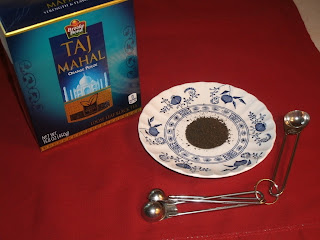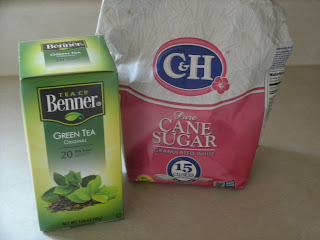Jordan and Oman
I'm giving you 2 posts this week. I have several posts built up, so I'm giving you a post about specific countries, and a generic post about the region. I hope you enjoy them.
Today we dive back into more variations on black tea. The only loose leaf black tea I have left is Assam which has a very strong flavor. I recently decided to buy some Lipton brand tea bags because I really don't remember using them, and Lipton is a popular brand in the region. I thought about cutting a tea bag open for my loose leaf, or just brewing it in the bag. I've also thought about going to the Indian grocery for the last few weeks, and I know that they have tea. Lots of tea. So yesterday I went, and realized that I know a lot more about tea now when I was looking at the boxes and bags.
There was Lipton. Yellow Label Lipton, which I've seen a lot of reference to. I don't know what the difference between this and regular Lipton is. It's kind of like when I went to Kenya and asked for Sprite. They asked if I wanted yellow dot or green dot. Huh? We only have Sprite, no dots. I was told that yellow dot had a more lemony flavor, and green dot had a more pronounced lime flavor. I really couldn't tell the difference from the American stuff, but then again I don't drink pop, soda, soda pop - whatever you want to call it, on a regular basis to remember what it tasted like in the states.
Since I already had Lipton, I decided to try a different (cheaper) brand. Enter Taj Mahal tea.
When I got it home, I looked more closely at the box and saw "Unilever". I had a wait a minute moment while I looked at my Lipton. Also "Unilever", I thought so. When I tried my Lipton tea, I could smell a bit of East African tea, and taste a bit of Assam tea. It is a pleasant blend. Taj Mahal tea has a slightly stronger Assam flavor than Lipton, but not quite as strong as straight Assam tea. I also saw loose leaf Darjeeling there, the smallest box was $9.00. I decided I didn't need any since I had some bagged tea that I used a few weeks ago when I needed Darjeeling. I did have a moment of pause knowing of the looming shortage of Darjeeling tea due to worker strikes in the Darjeeling region this year, but how much tea do I really need? But I digress, I combined 2 countries again today because of similarity of tea. Today we are infusing herbs. Not sweet herbs like cinnamon, ginger, cardamom, or cloves. Today we add some savory. I used the same base for both teas: 2 cups (500 ml) water and 2 teaspoons of tea. I brought the water to a boil, and simmered with the tea for 5 minutes.
Try as I might, the camera refused to focus in this shot. This is the best picture I got. I didn't know how much to use, so I put a scant 1/2 teaspoon in the infuser ball. Then I added the tea and steeped for several minutes.
The verdict. The thyme was really strong. Maybe just a sprinkle of dried thyme would be better. It is a stimulating drink, and I could see how it could be pleasant in the winter. It's a different taste than what I'm used to, but I would try it again (with less thyme).
The recipes all talk about adding dry sage. The only dry sage I have is ground, and I don't remember how old it is or what recipe I bought it for.
I cringed a bit at the thought of using this. I also didn't know how much to use (as demonstrated with my experiments with dried thyme in tea). As luck had it, I tried growing a window sill garden this summer. It hasn't done very well, but the sage seems to be the happiest of the herbs I'm growing (aside from the mint plant that I bought already started).
Here's a bonus shot of a flower that is doing much better than the herbs...
Anyway, I had forgotten until after I started brewing the tea that there was also cardamom in this tea, so I opted for a sprinkle of ground cardamom, and a spring of sage.
So I combined my ingredients and steeped for a few minutes.
Normally sugar and (canned) milk are added to the tea while it is boiling, but not for Jordan so I improvised. I warmed regular milk in the microwave, and then added some tea to it.
It was kind of an odd combination of flavors, but the milk diluted it down enough that I drank a cup. I can't say that I will be cooking with sage and cardamom together, but it was okay to try in tea. Like my sister, I'm not a huge fan of sweet and savory together, although I will tolerate a few select combinations.
Today we dive back into more variations on black tea. The only loose leaf black tea I have left is Assam which has a very strong flavor. I recently decided to buy some Lipton brand tea bags because I really don't remember using them, and Lipton is a popular brand in the region. I thought about cutting a tea bag open for my loose leaf, or just brewing it in the bag. I've also thought about going to the Indian grocery for the last few weeks, and I know that they have tea. Lots of tea. So yesterday I went, and realized that I know a lot more about tea now when I was looking at the boxes and bags.
There was Lipton. Yellow Label Lipton, which I've seen a lot of reference to. I don't know what the difference between this and regular Lipton is. It's kind of like when I went to Kenya and asked for Sprite. They asked if I wanted yellow dot or green dot. Huh? We only have Sprite, no dots. I was told that yellow dot had a more lemony flavor, and green dot had a more pronounced lime flavor. I really couldn't tell the difference from the American stuff, but then again I don't drink pop, soda, soda pop - whatever you want to call it, on a regular basis to remember what it tasted like in the states.
Since I already had Lipton, I decided to try a different (cheaper) brand. Enter Taj Mahal tea.
When I got it home, I looked more closely at the box and saw "Unilever". I had a wait a minute moment while I looked at my Lipton. Also "Unilever", I thought so. When I tried my Lipton tea, I could smell a bit of East African tea, and taste a bit of Assam tea. It is a pleasant blend. Taj Mahal tea has a slightly stronger Assam flavor than Lipton, but not quite as strong as straight Assam tea. I also saw loose leaf Darjeeling there, the smallest box was $9.00. I decided I didn't need any since I had some bagged tea that I used a few weeks ago when I needed Darjeeling. I did have a moment of pause knowing of the looming shortage of Darjeeling tea due to worker strikes in the Darjeeling region this year, but how much tea do I really need? But I digress, I combined 2 countries again today because of similarity of tea. Today we are infusing herbs. Not sweet herbs like cinnamon, ginger, cardamom, or cloves. Today we add some savory. I used the same base for both teas: 2 cups (500 ml) water and 2 teaspoons of tea. I brought the water to a boil, and simmered with the tea for 5 minutes.
Jordan
In Jordan, the videos agreed that the goal was to float as many of the tea leaves on top of the water as possible while the tea steeps. My tea is kind of little pellets, and they sank as soon as they hit the water. Oh well, better luck with a different style of loose leaf tea. I could go back to the other store and get some of that weak loose leaf Ceylon tea, but why? In the summer time, Jordanians add mint to their tea. In the winter they add thyme. While it is still summer here (although we had a cool front come through and actually make it pleasant here for a few days), I went with the thyme because I have already done mint.Try as I might, the camera refused to focus in this shot. This is the best picture I got. I didn't know how much to use, so I put a scant 1/2 teaspoon in the infuser ball. Then I added the tea and steeped for several minutes.
The verdict. The thyme was really strong. Maybe just a sprinkle of dried thyme would be better. It is a stimulating drink, and I could see how it could be pleasant in the winter. It's a different taste than what I'm used to, but I would try it again (with less thyme).
Oman
Bedouin sage tea
This tea gets a lot of attention and rave reviews in both video and text forms on the internet. Everyone agrees that this is best made over a camp fire. It is best if you remove the lid from the pot for a little bit while making it to get a smoky flavor. Considering I have never been camping, and I live in an apartment, the camp fire isn't happening. While I have seen a suggestion of using large clay flower pots as a grill, I see heat cracked pottery, and tea that tastes like lighter fluid. Stove top preparation it is.The recipes all talk about adding dry sage. The only dry sage I have is ground, and I don't remember how old it is or what recipe I bought it for.
I cringed a bit at the thought of using this. I also didn't know how much to use (as demonstrated with my experiments with dried thyme in tea). As luck had it, I tried growing a window sill garden this summer. It hasn't done very well, but the sage seems to be the happiest of the herbs I'm growing (aside from the mint plant that I bought already started).
Here's a bonus shot of a flower that is doing much better than the herbs...
Anyway, I had forgotten until after I started brewing the tea that there was also cardamom in this tea, so I opted for a sprinkle of ground cardamom, and a spring of sage.
So I combined my ingredients and steeped for a few minutes.
Normally sugar and (canned) milk are added to the tea while it is boiling, but not for Jordan so I improvised. I warmed regular milk in the microwave, and then added some tea to it.
It was kind of an odd combination of flavors, but the milk diluted it down enough that I drank a cup. I can't say that I will be cooking with sage and cardamom together, but it was okay to try in tea. Like my sister, I'm not a huge fan of sweet and savory together, although I will tolerate a few select combinations.












I would go with green dot Sprite!
ReplyDeleteYes you would. Honestly, we couldn't tell the difference.
Delete